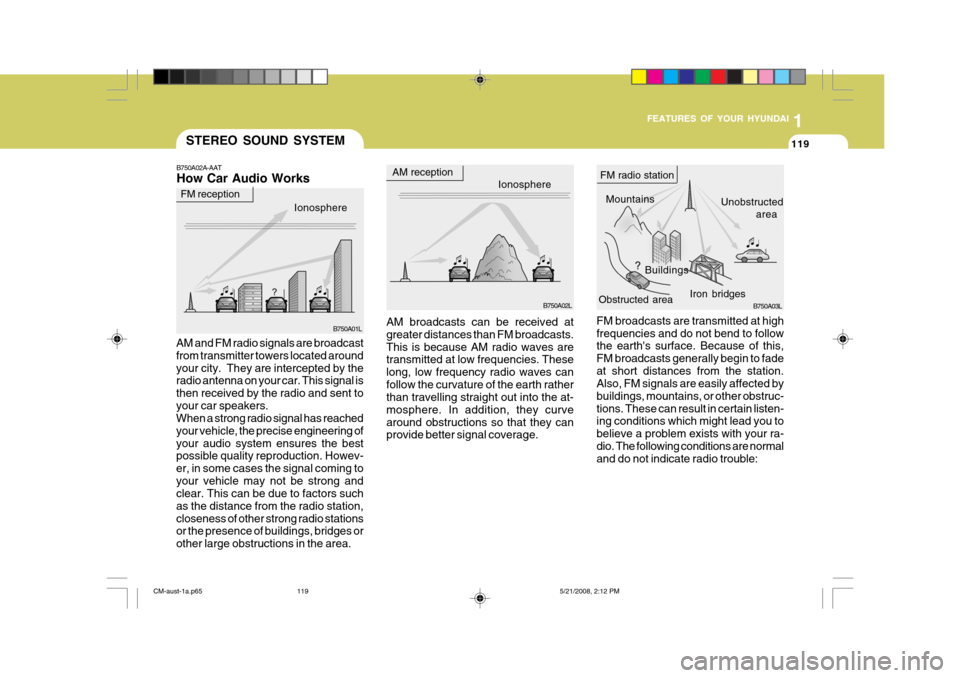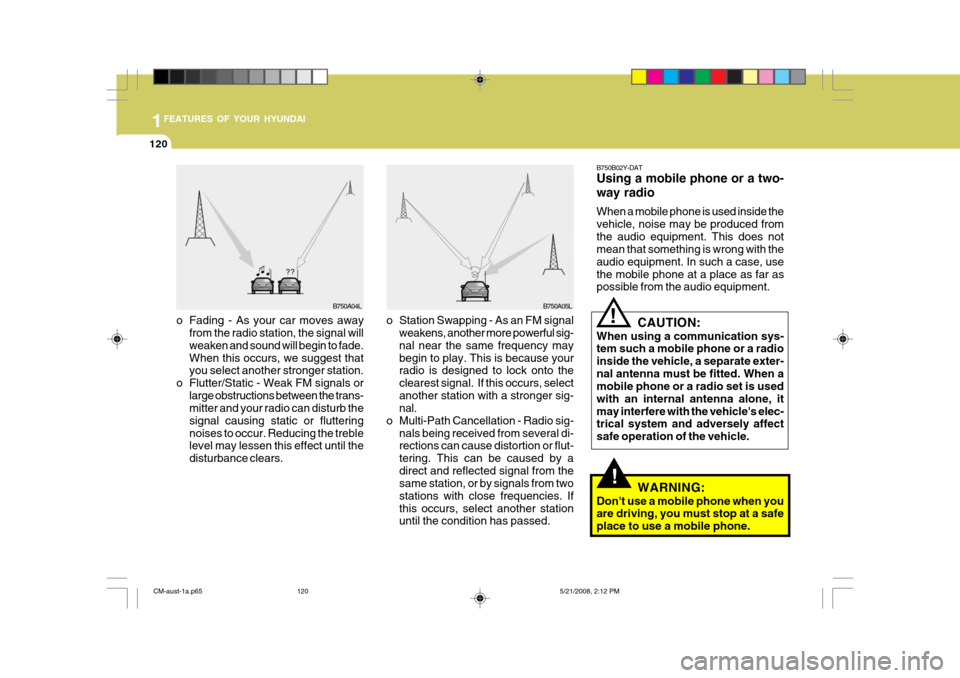radio antenna Hyundai Santa Fe 2009 Owner's Manual - RHD (UK, Australia)
[x] Cancel search | Manufacturer: HYUNDAI, Model Year: 2009, Model line: Santa Fe, Model: Hyundai Santa Fe 2009Pages: 269, PDF Size: 9.78 MB
Page 130 of 269

1
FEATURES OF YOUR HYUNDAI
119STEREO SOUND SYSTEM
AM reception
Ionosphere
FM reception
B750A01L
Ionosphere
B750A02L Mountains
Buildings Unobstructed
area
FM radio station
B750A03L
Obstructed area Iron bridges
FM broadcasts are transmitted at high frequencies and do not bend to follow the earth's surface. Because of this, FM broadcasts generally begin to fadeat short distances from the station. Also, FM signals are easily affected by buildings, mountains, or other obstruc-tions. These can result in certain listen- ing conditions which might lead you to believe a problem exists with your ra-dio. The following conditions are normal and do not indicate radio trouble:
AM broadcasts can be received atgreater distances than FM broadcasts. This is because AM radio waves are transmitted at low frequencies. These long, low frequency radio waves canfollow the curvature of the earth rather than travelling straight out into the at- mosphere. In addition, they curvearound obstructions so that they can provide better signal coverage.
B750A02A-AAT How Car Audio Works
AM and FM radio signals are broadcast from transmitter towers located aroundyour city. They are intercepted by the radio antenna on your car. This signal is then received by the radio and sent toyour car speakers. When a strong radio signal has reached your vehicle, the precise engineering ofyour audio system ensures the best possible quality reproduction. Howev- er, in some cases the signal coming toyour vehicle may not be strong and clear. This can be due to factors such as the distance from the radio station,closeness of other strong radio stations or the presence of buildings, bridges or other large obstructions in the area.
CM-aust-1a.p65 5/21/2008, 2:12 PM
119
Page 131 of 269

1FEATURES OF YOUR HYUNDAI
120
!
B750B02Y-DAT Using a mobile phone or a two- way radio When a mobile phone is used inside the vehicle, noise may be produced fromthe audio equipment. This does not mean that something is wrong with the audio equipment. In such a case, usethe mobile phone at a place as far as possible from the audio equipment.
CAUTION:
When using a communication sys-tem such a mobile phone or a radio inside the vehicle, a separate exter-nal antenna must be fitted. When a mobile phone or a radio set is used with an internal antenna alone, itmay interfere with the vehicle's elec- trical system and adversely affect safe operation of the vehicle.
WARNING:
Don't use a mobile phone when you are driving, you must stop at a safe place to use a mobile phone.
!
B750A04L B750A05L
o Station Swapping - As an FM signal weakens, another more powerful sig- nal near the same frequency may begin to play. This is because your radio is designed to lock onto the clearest signal. If this occurs, selectanother station with a stronger sig- nal.
o Multi-Path Cancellation - Radio sig- nals being received from several di-rections can cause distortion or flut- tering. This can be caused by adirect and reflected signal from the same station, or by signals from two stations with close frequencies. Ifthis occurs, select another station until the condition has passed.
o Fading - As your car moves away
from the radio station, the signal willweaken and sound will begin to fade. When this occurs, we suggest that you select another stronger station.
o Flutter/Static - Weak FM signals or large obstructions between the trans-mitter and your radio can disturb the signal causing static or flutteringnoises to occur. Reducing the treble level may lessen this effect until the disturbance clears.
CM-aust-1a.p65 5/21/2008, 2:12 PM
120